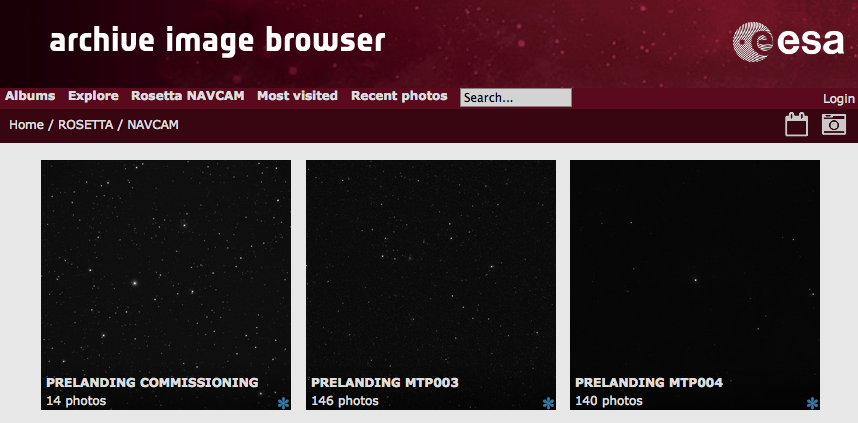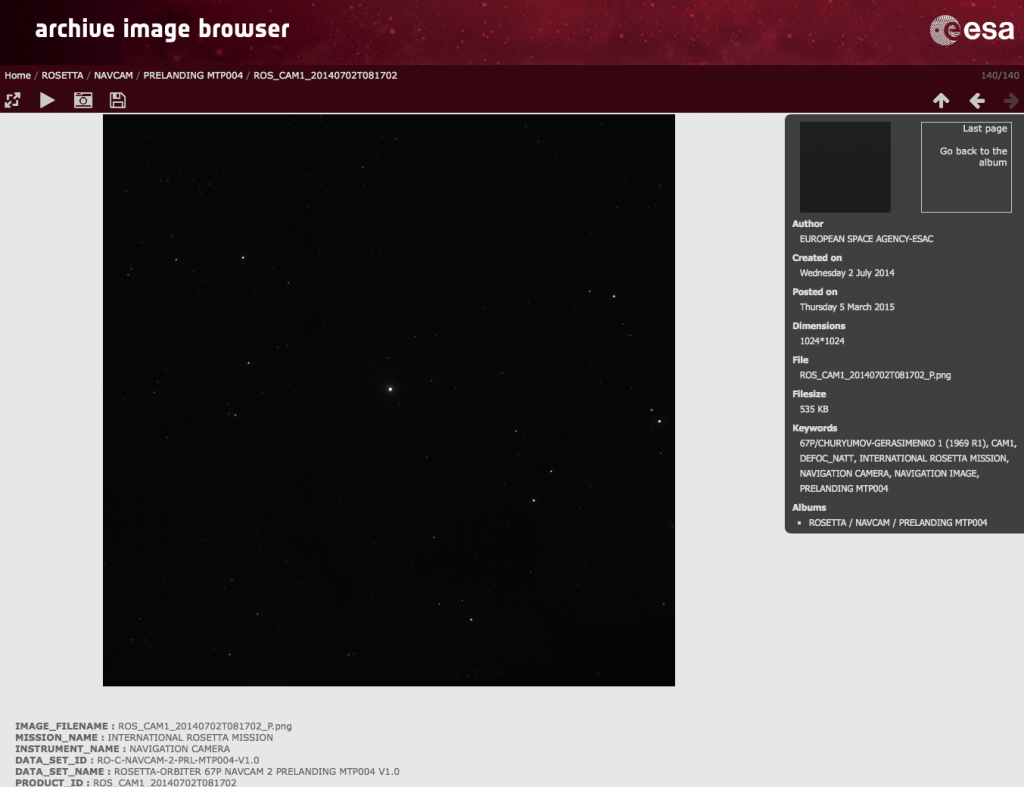We are happy to announce that the first set of images from Rosetta’s NAVCAM has now been made available to all scientific and public users via ESA’s Planetary Science Archive (PSA). This first batch of image data covers the period leading up to 2 July 2014, prior to Rosetta’s arrival at 67P/C-G. Further releases of image data will be made in blocks on a monthly basis henceforth, with the near-term aim to catch-up so that NAVCAM data will be publicly released six months after they are taken.
In addition to the usual Planetary Science Archive interface, the archive team at ESAC in Spain has also implemented a new tool – hosted at imagearchives.esac.esa.int – to enable rapid browsing of the available NAVCAM image data. Standard pipeline processed images can be viewed in PNG format in the browser, and the user will then be able to download the original unprocessed data sets for the chosen images, in FITS and PDS formats, including the full header (metadata) information.

The archive image browser launched today with access to NAVCAM images from the post wake-up and commissioning period in early 2014, to 2 July 2014.
These NAVCAM data are fully and freely public, and are geared towards the scientific community or for those with an interest in data and image processing. For the general public, however, we recommend looking out for the fully-processed images that we regularly publish via the following outreach channels:
–This blog, as part of our regular CometWatch series
-The image collections available on our Science & Technology pages: “67P by Rosetta” (publicly released OSIRIS and NAVCAM images) and “67P – NAVCAM” (NavCam images)
-ESA main Portal image gallery (search for Rosetta for all images linked to the Rosetta mission and that have been released e.g. via news stories/press releases)
-Our Rosetta social media platforms on Facebook, Twitter, and Instagram and wider ESA social media, including Flickr and Google+
For more information about the new image browser and associated data releases, please check the Q&A below:
Who is the viewer for?
If you enjoy seeing new images of the comet but are happy with the fully-processed images released 2–3 times a week in our CometWatch blog posts, then simply stick with us here, and/or browse the image galleries highlighted above. But if you would like access to all images in the NAVCAM image archive along with context information for each, then the NAVCAM browser is for you. For scientists wishing to process the raw data and perform detailed analysis, they can also access the PSA to download the full data sets contained there.
What format are the images in the NAVCAM browser?
The standard output image is a PNG file, but links are also provided to download the images in FITS and PDS format. Information about NAVCAM and the properties of the images are available in the browser (here).
Have the images been processed in any way?
For the PNG files, some basic cleaning scripts have been applied to remove so-called double pixel pairs – dark/bright pixels beside one another. If you are interested to read more, please refer to the processing information contained in the NAVCAM image browser (here). The FITS and PDS files are in raw and unprocessed form.

Metadata for each image is provided, along with links to download the image in other formats (note that more information is displayed than shown in this screenshot)
What reference data do I see with the images?
With each image, you will also find information including the date/time the image was taken (year-month-day and hour:minutes:seconds format in UTC, on-board spacecraft time); the distance to the centre of the comet (km); and the exposure time of the image (seconds). All metadata produced is available in the label file provided with each image and detailed information can be found in the PSA in the usual way.
How are the images organised?
The images are contained in folders linked to the planning periods of the Rosetta scheduled activities. These are known as MTP’s (Medium Term Plans), where one MTP typically corresponds to approximately four weeks of Rosetta scheduled activities during “normal business” (this varies if special events are scheduled, such as during the lander separation activities). For example, images from MTP001 and MTP002 are contained in the “Prelanding Commissioning” folder and they cover the period after wake-up in January 2014 and for the instrument commissioning phase until early May, while MTP003 and 004 are for four-week periods and include the first detection of the comet.
You can also search for images via keyword, date, most visited, date added, and so on.
Can I download and share the images myself?
Yes, just like the images we publish in the regular CometWatch series, all NAVCAM images accessible via the new viewer are released under the so-called CC BY-SA 3.0 IGO licence – the “attribution share-alike” creative commons licence. For more info, see our blog post: Rosetta NAVCAM images now available under a creative commons licence.
How often will the image viewer be updated?
In the first release (today, 6 March), images are being released from the period following Rosetta’s wake-up in January 2014 until 2 July 2014 (300 images). Note that these are from the approach phase to Comet 67P/C-G, and so do not feature any close up images – these will come in the next releases. While the future releases will follow a monthly release schedule, the near-term aim is to catch-up to the point where NAVCAM data will be publicly released approximately six months after they are taken. We will also continue to bring you our regular CometWatch feature to highlight more recent images.
How will I know when there’s a new release of images in the viewer?
The image browser has a page to enable RSS feeds (here) providing notification when new images are added to the archive image browser. We will also include a reminder here on the blog as part of the one of the regular CometWatch releases of that week.
When will OSIRIS images and other data from the mission be available?
The new image viewer is essentially a ‘beta release’ and is currently exclusively for NAVCAM images. However, it is planned to extend it to include data from other Rosetta instruments: the release of scientific data from these instruments covering the period January–November 2014 is foreseen starting in May 2015, depending on the instrument.
Don’t forget that data from many instruments (including OSIRIS) are already available on PSA from the cruise phase of the mission, prior to hibernation entry in July 2011. NAVCAM images from the cruise phase will also be added to the browser in due course.
What about access to data from other missions?
In the future, the goal is for this tool to be extended to allow wider access to image data from other ESA space science missions whose data are held in the PSA or other archives.
Your feedback is welcome on the new browser to help the archive team improve it in future versions – please posts comments below. Please note that any comments not directly relating to the topic of the viewer as currently implemented for NAVCAM will not be approved on this post.









Discussion: 11 comments
This is great for the casual public, such as myself. I’m sure scientist can make good use of such browsing as well. So good job and thank you!
One thing I’m curious about is how you will present different corrections needed at different times. As an example, right now the image processing information for the NAVCAM images contain the use of images from 2014 for background subtraction, but that might not be valid for say an image from 2005. Especially now that Rosetta is escorting the comet you could image dust getting stuck that would change the processing. Is the “Image processing information” link going to link to different pages as appropriate?
The same thing might also go somewhat for the “Copyright information” link with different copyrights. Say you for some reason add a Rosetta NAVCAM image that is further processed and should contain some additional credits apart from the standard ESA/Rosetta/NAVCAM – CC BY-SA IGO 3.0. Or an NAVCAM image that for some reason or another isn’t even under a CC BY-SA license but instead is entirely free to use.
Hi Daniel, I’ve passed your question on to the team. Will get back to you.
Hi Daniel, to answer your questions: the processing description provided is valid/best for images May 2014 onwards (TBD what products might become available at a later date).
For the copyright, the standard ESA/Rosetta/NAVCAM – CC BY-SA IGO 3.0 applies to all NAVCAM images that we release.
Thank you, I appreciate the answer, but it seems my question wasn’t clear enough.
This is only theoretical at this point as there might not be any differences. However let’s say we have these made up differences in how NAVCAM images are to be processed depending on when they were taken.
NAVCAM images from 2005 has processing steps:
A > B > C > D
NAVCAM images from 2014 has processing steps
A > B > C > E > D
NAVCAM images from Q1 2015 has processing steps
G > B > C > E > D
How will this be reflected in “image processing information” page? Would there be separate information pages for images from 2005, 2014, Q1 2015? Would there only be a unified page that outlines the differences in how they are processed?
Many, many thanks indeed Emily, this is fantastic news. Exactly what I was hoping ESA would be able to do. The slideshows should be fun when the approach phase nears the comet.
For us highly interested armchair viewers this is brilliant and for the more geeky among us easier access to the raw data too. Congrats and big thanks to the ESAC team for this excellent common sense solution.
Great work, and your efforts are much appreciated, Team.
–Bill
Very intersting and usefull. Thanks a lot to the NAVCAM team !!
Why, on the contrary, the absurd embargo of the OSIRIS pictures? Why OSIRIS team released only a few cropped low resolution pictures inside a couple of Science paper?
OSIRIS team should learn a lot from NASA Dawn team that releases immediately all the historic Ceres pictures, without the fear that someone could steal them.
this is much more than you could hope for!
Thanks ESA .. and … may the force be with you
Bravo to the ESAC Team at Spain. World Wide Web was built to host efforts like yours. To you and all Out-Reach efforts would like to say not to be baffled by the low visit numbers. We general public are used to textbook, museum curated science. Not even knowing how to approach, ask and participate. This is new and amazing!
This has to be said. I insinuated doubt and sometimes even expressed it about ESA fulfilling the six month issue. I was definitely wrong.
I wonder if it would be possible to use photogrammetry or some other kind of image processing technique to reconstruct the topography of the comet in 3D.
The images seem especially well stabilised relative to one another. I imagine the process would take in a few sets of those images and solve for the incoming light direction as well topographic information.